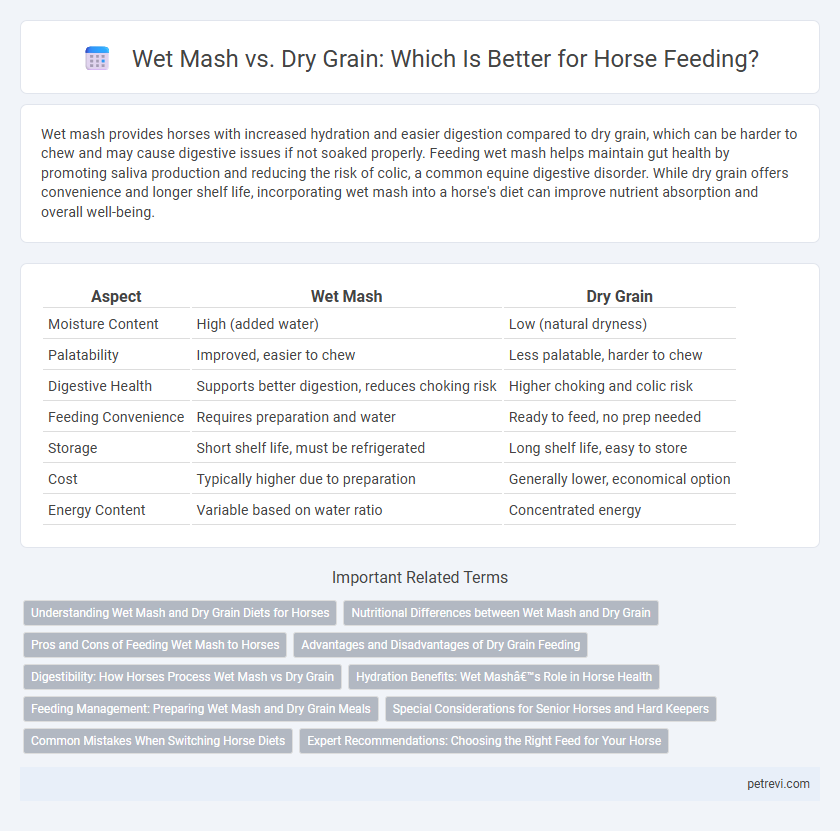Wet mash provides horses with increased hydration and easier digestion compared to dry grain, which can be harder to chew and may cause digestive issues if not soaked properly. Feeding wet mash helps maintain gut health by promoting saliva production and reducing the risk of colic, a common equine digestive disorder. While dry grain offers convenience and longer shelf life, incorporating wet mash into a horse's diet can improve nutrient absorption and overall well-being.
Table of Comparison
| Aspect | Wet Mash | Dry Grain |
|---|---|---|
| Moisture Content | High (added water) | Low (natural dryness) |
| Palatability | Improved, easier to chew | Less palatable, harder to chew |
| Digestive Health | Supports better digestion, reduces choking risk | Higher choking and colic risk |
| Feeding Convenience | Requires preparation and water | Ready to feed, no prep needed |
| Storage | Short shelf life, must be refrigerated | Long shelf life, easy to store |
| Cost | Typically higher due to preparation | Generally lower, economical option |
| Energy Content | Variable based on water ratio | Concentrated energy |
Understanding Wet Mash and Dry Grain Diets for Horses
Wet mash diets for horses involve soaking grains and other feed components in water, enhancing hydration and aiding digestion by softening the feed. Dry grain diets consist of unmoistened cereal grains like oats, barley, or corn, providing concentrated energy and nutrients but requiring ample water intake to prevent digestive issues. Understanding the differences in moisture content and digestibility between wet mash and dry grain helps optimize equine nutrition based on individual horse needs and health conditions.
Nutritional Differences between Wet Mash and Dry Grain
Wet mash offers higher water content, improving hydration and digestion in horses compared to dry grain, which is denser and less hydrating. Nutritionally, wet mash generally provides more digestible fiber and enhanced nutrient absorption due to increased moisture softening the feed. Dry grain contains concentrated energy and fiber but risks reduced palatability and slower digestion when fed without adequate water.
Pros and Cons of Feeding Wet Mash to Horses
Feeding wet mash to horses provides enhanced hydration and improved digestion due to increased moisture content, which can aid in nutrient absorption and prevent colic. The softened feed is easier to chew and palatable for picky eaters, but wet mash requires careful preparation and storage to avoid spoilage and bacterial growth. Over-reliance on wet mash may reduce fiber intake compared to dry grain, potentially impacting gut health if not balanced with adequate roughage.
Advantages and Disadvantages of Dry Grain Feeding
Dry grain feeding offers concentrated energy and nutrients vital for high-performance horses but poses risks of digestive disturbances like colic or choke if not properly managed. It requires careful portion control and ample water intake to prevent dehydration and promote efficient digestion. Despite convenience and longer shelf life, dry grain demands strict feeding protocols to maintain equine gut health and avoid metabolic issues.
Digestibility: How Horses Process Wet Mash vs Dry Grain
Horses digest wet mash more efficiently than dry grain due to increased moisture content that enhances enzymatic activity and nutrient absorption in the gastrointestinal tract. Wet mash softens fibrous material, promoting faster microbial fermentation in the hindgut, which is crucial for breaking down cellulose. Dry grain, while energy-dense, requires more digestive effort and may lead to reduced nutrient availability compared to the hydrated, pre-soaked composition of wet mash.
Hydration Benefits: Wet Mash’s Role in Horse Health
Wet mash significantly enhances horse hydration by providing a higher moisture content compared to dry grain, which supports optimal digestive function and prevents dehydration-related issues. Horses consuming wet mash experience improved nutrient absorption, reduced risk of colic, and better overall gut health due to the increased water intake embedded in the feed. Consistent hydration from wet mash also aids in maintaining electrolyte balance and promoting efficient metabolic processes essential for equine performance and recovery.
Feeding Management: Preparing Wet Mash and Dry Grain Meals
Preparing wet mash for horse feeding involves soaking grains and fibers in water to create a palatable, hydrated meal that aids digestion and reduces choking risks. Dry grain meals require careful portioning and gradual introduction to prevent digestive upset and maintain optimal nutrient absorption. Effective feeding management balances moisture levels to support gut health and ensure consistent energy supply.
Special Considerations for Senior Horses and Hard Keepers
Wet mash provides enhanced hydration and easier digestion, crucial for senior horses and hard keepers with compromised dental health or reduced digestive efficiency. Dry grain offers concentrated calories but may increase the risk of choking and digestive upset in older or metabolically challenged horses. Tailoring feeding strategies to individual needs, including incorporating soaked feeds or specialized senior formulations, optimizes nutrient absorption and supports overall equine health.
Common Mistakes When Switching Horse Diets
Switching from dry grain to wet mash in horse feeding often leads to common mistakes such as incorrect water-to-grain ratios, causing digestive upset or nutrient imbalance. Overhydrating grains can reduce nutrient density and increase the risk of spoilage, while underhydrating fails to prevent choking hazards. Properly balancing moisture content and gradually transitioning diets help maintain equine gastrointestinal health and nutrient absorption.
Expert Recommendations: Choosing the Right Feed for Your Horse
Expert recommendations emphasize that wet mash feeding enhances water intake and digestibility, reducing the risk of colic in horses. Dry grain offers concentrated nutrients and easier storage, but requires thorough chewing to prevent choking hazards. Selecting the appropriate feed depends on the horse's health, age, and workload, with veterinary guidance advised for tailored nutrition plans.
Wet Mash vs Dry Grain for Horse Feeding Infographic

 petrevi.com
petrevi.com